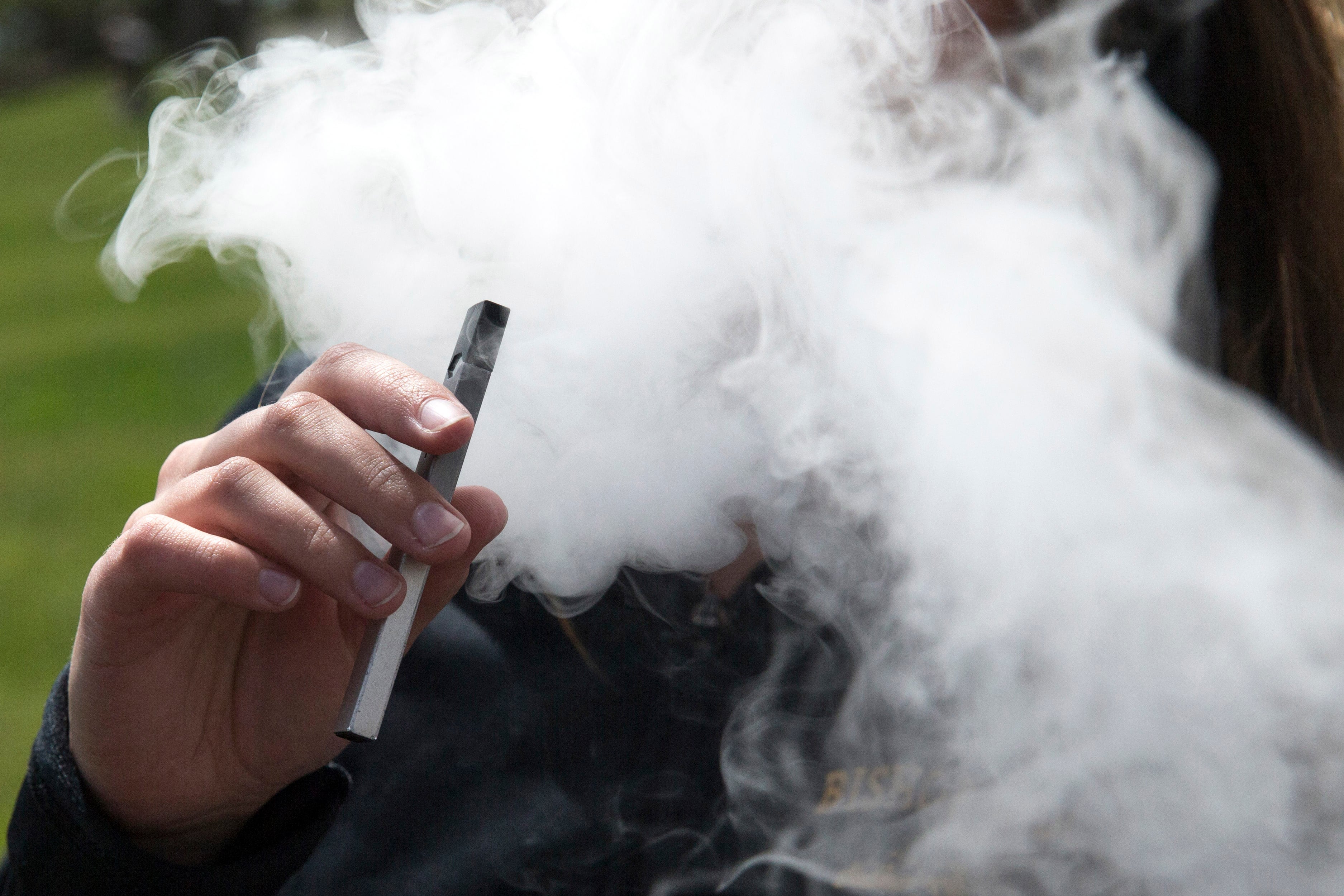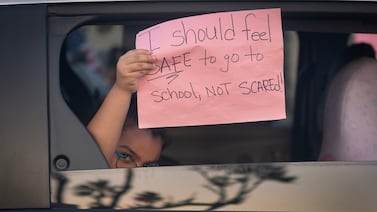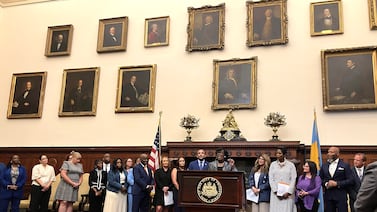New York City is set to receive $27 million to combat youth vaping as part of a settlement stemming from a lawsuit against e-cigarette giant Juul, state Attorney General Letitia James announced Wednesday.
James led a multistate lawsuit against Juul in 2019 for deceptive marketing targeting youth and won a $462 million settlement. New York State is receiving $112 million of that sum, with $27 million flowing directly to the city to confront what James called a “youth vaping epidemic” that Juul helped spark. Of that allotment, $15 million will go directly to the public school system, and the remaining $12 million will go to other parts of city government.
The money will be distributed in a series of payments over the coming eight years, and districts will get wide discretion on how to spend their money in five general areas: education, prevention, enforcement, and research on the effectiveness of anti-vaping efforts.
“The smell of vapes has been commonplace in hallways, cafeterias, and stairwells,” James said of Manhattan’s Martin Luther King Jr. high school campus where she announced the new funding.
At other schools, James acknowledged, “vaping … became so frequent and widespread that schools had to install vaping detection devices inside of school bathrooms and in other rooms.”
Some school districts across the country have used their Juul settlement money to purchase vape sensors, which detect the chemicals emitted during vaping. A New York City program to buy vape detectors could be a permissible expense as long as it meets the other criteria for the funding, James’s office said.
One Manhattan principal who installed sensors this year to curb student vaping in the school’s bathrooms hopes the city will subsidize the devices. The detectors have been a game changer: The school initially saw roughly 60 vape alerts a week, and now they come only several times a month, according to the school leader.
This principal would also like the city to fund more substance abuse counselors to work in schools and argued that educators and school leaders should have a role in deciding how the funding is allocated.
“I will volunteer my time,” added the administrator, who spoke on the condition of anonymity because they’re unsure if the vape sensors are approved by the Education Department.
Officials from the Education Department and the Adams administration didn’t immediately respond to questions about how the city plans to spend its settlement money.
A national teen vape crisis takes hold
Vapes, or e-cigarettes, function by heating small liquid cartridges containing nicotine, often alongside flavoring and other chemicals, into an aerosol that can be inhaled. Concentrates of THC, the active ingredient in cannabis, can also be vaporized.
There are signs that nicotine vaping can lead to lung disease, though the long-term effects on the lungs are still being studied. Nicotine can change the chemistry of the adolescent brain, affecting memory, concentration and learning ability, city health officials said last November. A 17-year-old in the Bronx died from vaping in 2019 – the youngest vaping casualty in the country.
Rates of teen vaping across the nation have exploded over the past decade or so.
The share of high school seniors who said they’d vaped nicotine in the past month jumped from 11% in 2017 to 21% in 2022, according to the University of Michigan’s Monitoring the Future study. The percentage who’d vaped marijuana in the past 30 days shot up from 5% in 2017 to 15% in 2022, the study found.
In New York City, roughly one in nine city teens reported vaping at least once in the past 30 days in 2021, the last year for which survey results were published in the national Youth Risk Behavior Survey. Girls were more than twice as likely than boys to report vaping, with 15% saying they’d smoked an e-cigarette in the last month, compared to 7% of boys.
Public health officials and state attorneys general have pointed to Juul’s singular role in fomenting the rise in youth vaping.
According to the lawsuit filed by James’s office in 2019, Juul systematically marketed its products to young people by emphasizing the fruity flavors and downplaying or hiding the health risks, violating state laws against selling tobacco products to minors in the process.
The suit claims that a Juul representative reached out directly to at least one New York City high school and “falsely told high school freshmen that its products were safer than cigarettes.”
Some educators and city students say the proliferation of smoke shops across the city in the wake of the state’s rocky rollout of legalized weed in 2021 has made the products even more accessible. And the ongoing youth mental health crisis accelerated by the pandemic has pushed more teens to turn to substances like cannabis and nicotine as a form of stress relief and self-medication, according to educators and mental health professionals.
The problem often spills directly into schools, with students vaping in bathrooms and hallways, according to educators and kids.
At Beacon High School in Hell’s Kitchen, 18-year-old senior Ava Stryker-Robbins recalled opening a bathroom door to be greeted by a cloud of smoke. She now avoids that restroom.
“I’ve heard people who have asthma say that there are some bathrooms in the school that they cannot use throughout the day because of the amount of smoke,” she said.
Beacon’s principal didn’t respond to an email asking about the school’s approach to student vaping.
Incidents of controlled substances confiscated in schools rose last year compared to before the pandemic, but are down roughly 24% this year compared to last year, according to an Education Department spokesperson.
Schools struggle with lack of anti-vaping resources
Educators and school leaders said they often feel mostly on their own when it comes to confronting widespread student vaping.
There are currently only 256 dedicated Substance Abuse Prevention and Intervention Specialists distributed across the city’s more than 1,600 public schools, according to recent testimony from District Council 37 Local 372, the union representing the workers.
That’s a loss of more than 200 SAPIS workers since 2006, due to the expiration of a federal grant, according to the union.
An Education Department spokesperson said SAPIS workers are placed based on reviews of schools’ needs and requests from principals. They can offer class lessons, small group counseling, parent workshops, and referrals to outside support.
Yvonne Perez, a school social worker at West Brooklyn Community High School, a transfer school for students at risk of not graduating, said she’s tried to bring in outside resources like a group that teaches harm reduction techniques that seek to reduce rather than outright eliminate the behavior, instead of relying on discipline.
“I’m always big on understanding,” she said. “Let’s not judge them or place an opinion on them for doing what they’re doing. They’re coping.”
But the scale of the challenge can be daunting. “We’ve been seeing a lot of our students smoking weed and vaping like it’s nothing,” she said.
City Council Member Gale Brewer, a democrat who represents the Upper West Side of Manhattan, said the explosion of smoke shops has created a significant challenge for schools.
“Schools need help,” she said at the Wednesday press conference. “I’ve even had a principal crying … because when you have a young woman vaping in your classroom, it’s really challenging. What in the world do I do? Where do I begin? How do I get her support?”
The city’s Education and Health Departments announced a partnership last November with the CATCH Global Foundation to offer an evidence-based anti-vaping curriculum to roughly 30,000 students across 180 schools over the next three years. City health educators will also be eligible to receive the training, according to officials.
Schools experiment with vape detectors
Some New York City school leaders have leaned on vape sensors in bathrooms and hallways to address the issue.
It’s not clear how many schools in New York City use the devices, and there have not been any district-wide initiatives to purchase them. But some individual schools have bought the sensors.
Zeptive, a Massachusetts-based company that produces vape detectors, works with about 30 New York City public and charter schools — a number that’s grown in recent years, according to chief growth officer Steve Milt.
State Sen. Nathalia Fernandez (D-Bronx) introduced a bill last year that would require all New York City schools to install vape detectors. The bill hasn’t advanced past committee.
The Manhattan principal who installed vape sensors at the start of this school year did so after hearing complaints from students about pervasive vaping in the bathrooms.
“‘I don’t like the smell, I don’t like the vibe of going into a bathroom and seeing someone smoking, it doesn’t feel safe,’” the principal recalled students saying. “That was enough for me.”
At first, responding to the frequent alerts required a significant time commitment from administrators. The school arranged meetings with families of students who were caught vaping and referred students to substance abuse treatment if the problem persisted.
Over time, the number of alerts dropped precipitously. The devices made “visible” a problem that was largely out of sight,the principal said, and opened up valuable conversations with students and parents.
But not everyone is sold on vape sensors. One Brooklyn principal looked into buying them but scrapped the idea over privacy concerns, he said.
Critics have raised concerns over the accuracy of the sensors and the potential that they could open students up to harsh discipline. In Texas, teens caught vaping in school by sensors have faced month-long suspensions and misdemeanor charges, according to the Associated Press.
“There just are so many issues here as to why do you think you need it, does it really work, what are the policies you’re putting into place, are you going to end up applying the consequences in a way that has a disproportionate impact on kids of color?” said Beth Haroules, a senior staff attorney at the New York Civil Liberties Union.
The Manhattan principal who installed vape sensors acknowledged the devices are a limited tool and can’t solve the “societal” problem of youth vaping. But the school leader stressed that curbing the practice in school is a critical first step.
“This is my home, and these are my kids,” the principal said. “I really want the best community and the best environment for my kids.”
Michael Elsen-Rooney is a reporter for Chalkbeat New York, covering NYC public schools. Contact Michael at melsen-rooney@chalkbeat.org.







